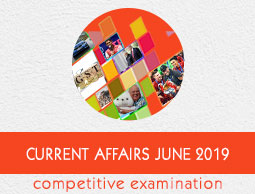
- Appointments
- Awards
- Banking and Finance
- Bills and Acts
- Books and Authors
- Business and Economy
- Committees
- Deaths
- Defence
- Environment
- Important Days
- International
- Miscellaneous
- National
- Resignations
- Reports
- Regional
- Sports
- Science and Technology
- June 2019 - Exams Resources
- Current Affairs - Quiz
- Current Affairs - Test
- Current Affairs - PDF
Current Affairs June 2019 - Science & Technology
1 - NASA announced a new mission to explore Saturn's largest moon
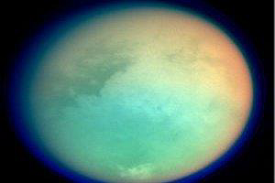
NASA announced a new mission to explore this fascinating world with a helicopter drone. The mission, called Dragonfly is the latest in NASAs New frontier program. NASA has earlier launched explorations of Pluto, Jupiter, the asteroid Bennu, and now, Titan.
Titan
Titan, the largest moon of Saturn, has a lot in common with Earth. It has a thick, nitrogen-dense atmosphere and features like rivers, lakes, mountains, and, potentially volcanoes. The atmosphere of Titan is four times as dense as the Earths and theres less gravity which makes it a prime location in the solar system to deploy a drone.
Dragonfly
Dragonfly is planned to launch in 2026 and arrive at Titan in 2034. With its eight rotors, Dragonfly will be able to fly tens of miles in a given day. It is powered by a plutonium battery.
Two-year mission, Dragonfly will travel hundreds of miles across the surface. sampling the chemistry of the moon and studying its geology and atmosphere. It will also look out for signs of life.
The study on Titans methane cycle is interesting as Methane (the primary ingredient in natural gas) actually forms clouds and rains down on the surface of Titan, a lot like how water rains on Earth.
By studying the weather pattern on Titan, a better picture about the greater reaches of the cosmos, and help scientists understand what makes a planet or moon habitable or not.Giant asteroid 99942 Apophis will fly past Earth in a decade
The 340m wide asteroid named 99942 Apophis will fly past Earth like a moving star- like point of light on April 13, 2029. It will fly above the earths surface at 30,500 km and first become visible with a naked eye in the night sky over the Southern Hemisphere from the east coast to the west coast of Australia.
2 - NASA's Curiosity rover confirmed the presence of Methane in Mars
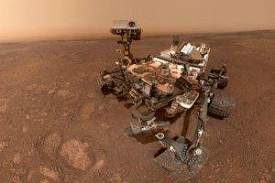
NASA has confirmed that the Curiosity rover, the NASA's Mars Science Laboratory mission, recently detected the largest amount of methane ever measured during the mission. Curiosity's methane reading came to 21 parts per billion units by volume. It is thrice the amount it sniffed out during a surge in 2013.
During a follow-up test later, though, scientists found that the methane levels around the rover already dropped sharply. Curiosity detected normal methane levels, that is 1 part per billion by volume, following the sudden elevation. It suggested that the abnormally high values came from transient methane plumes.
As Curiosity is not equipped with instruments to determine whether the source of methane is biological or geological, the scientists are yet to figure out a pattern for Martian's transient plumes.
The scientists plan to gather more information through Curiosity and from other missions to gain a deeper understanding of the plumes. The scientist will be able to understand whether the presence of methane on the red planet truly is a sign of life only if they finds where the plumes are coming from.
Methane
Methane is a gas formed by both geological and biological processes.
It is the main constituent of natural gas. It is a group-14 hydride and the simplest alkane with the chemical formula CH4.
The methane concentration in earth's atmospheric has increased by about 150% since 1750.
Methane accounts for 20% of the total radiative forcing from all of the long-lived and globally mixed greenhouse gases.
3 - Three astronauts landed after spending more than six months aboard the International Space Station (ISS)
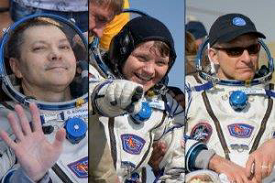
Oleg Kononenko with the Russian space agency Roscosmos, Anne McClain of NASA and Canadian Space Agency astronaut David Saint-Jacques landed aboard Russia's Soyuz MS-11 spacecraft on June 24. The landed after spending more than six months aboard the International Space Station (ISS).
Astronauts Anne McClain of the United States and David Saint-Jacques of Canada had completed their maiden flights. The expedition commander Oleg Kononenko of Russia has ended his fourth space mission. All three spent 204 days in space.
Soyuz MS-11 was the 57th Russian Soyuz spacecraft to fly to the International Space Station. It traveled a total of 86.4 million miles (139 million kilometers) over the course of 3,264 orbits of Earth.
4 - India has the highest data usage per smartphone in the World: Report

According to the Ericsson Mobility Report, monthly data usage per smartphone in India rose to 9.8 gigabytes (GB) at the end of 2018, the highest in the world.
It is expected that, Monthly data usage per smartphone would grow at 11 percent to reach 18 GB by 2024 from 9.8 GB in 2018.
The report also projects that total mobile data usage per month in the country will go up 23 per cent in the coming five years, rising from 4.6 exabytes (EB) presently to 16 EB. One EB equals one billion GB.
At the end of 2018, there were 5.1 billion smartphone subscribers globally, 99 percent of which were for 3G and 4G. North East Asia comes second with 7.1GB per month.
5 - ISRO opens its laboratories for Indian school students
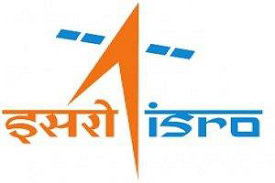
Indian Space Research Organisation (ISRO) is an agency which has the legacy of Indias ancient knowledge and modern technology.
She opened its laboratories for Indian school students to undergo two-week training from this year.
first batch 108 students drawn from all states.
Union Territories completed their exposure in its laboratories in Bengaluru, Sriharikota, Thiruvananthapuram.
The training module devised as part of its new Young Scientists Programme.
Yuva Vigyanik Karyakram, YUVIKA.
ISROs YUVIKA is modeled around the Indian governments vision Jai Vigyan, Jai Anusandhan.
The initiative is primarily aimed at imparting basic knowledge on Space Technology, Space Science and Space Applications to children to kindle their interest in the emerging areas of space activities.
The two-week-long program would include invited talks, experience sharing by eminent scientists, facility and lab visits, exclusive sessions for discussions with experts, practical and feedback sessions.
About Indian Space Research Organisation (ISRO)
Formation:15 August 1969
Headquarters: Bengaluru, Karnataka, India.
6 - Scientists places worlds highest weather stations atop Mount Everest
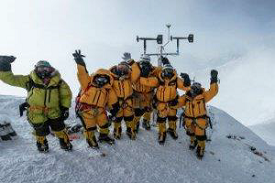
Scientists from National Geographic Society and Tribhuvan University installed have installed two highest weather stations in the world in an expedition to Mount Everest that wrapped up in June 2019. The two weather monitoring stations are located at an altitude of 8,430 meters (27,657 feet) and 7,945 meters (26,066 feet). Also, three other stations have been set up across the Mount Everest.
The setting up of the weather station aim to collect weather data. The data gathered from the stations will help scientists to understand how rising global temperatures impacts the rapidly melting glaciers.
The nearly two month expedition involved a team of more than 30 scientists from all over the world, including 17 Nepali researchers. The team also collected the world highest ice core sample at 8,020 meters , which will help the scientists study the deep record of precipitation on the mountain and composition of the atmosphere during pre-industrial times.
The project also reached another milestone of placing the world's highest helicopter-based lidar scan and the most detailed photogrammetric imaging, also with lidar scans, of the Everest Base Camp area and the entire Khumbu Glacier.
7 - Two female scientists Ritu Kridhal and Vanitha to head Indias 2nd Moon mission Chandrayaan-2
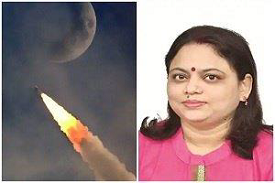
For the first time, Indian Space Research Organisation (ISRO) has appointed two women scientists - Ritu Karidhal (as mission director) and Muthayya Vanitha (as project director) - to head the India's second Moon mission Chandrayaan-2.
ISRO Chairman K Sivan announced that close to 30 percent of the ISRO team working on Chandrayaan 2 are women.
Ritu Karidhal was referred as the 'Rocket Woman of India'. She became famous with the launch of the Mars Orbiter Mission where she was the deputy operations director.
Muthayya Vanitha received the Best Woman Scientist award in 2006 by the Astronomical Society of India.
About Chandrayaan-2
Chandrayaan-2 is India's second mission to explore moon after Chandrayaan-1.
Developed by: ISRO
The Chandrayaan-2 mission is scheduled to launch on July 15.
The project cost is close to Rs 1,000 crore with the involvement of close to 600 industries and 15 academia collaboration.
8 - NASAs OSIRIS REx spacecraft creates new record
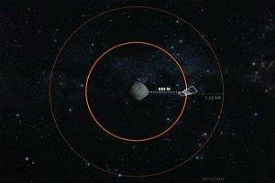
NASAs OSIRIS-REx spacecraft entered its second orbital phase around asteroid Bennu, called Orbital B on June 12, 2019. It broke its own world record for the closest orbit of a planetary body.
In the Orbital B phase, the maneuver placed the spacecraft in an orbit 680 meters above the surface of asteroid Bennu. The previous record was set by OSIRIS-REx on 31 December, 2018, when the spacecraft flew 1.33 km above the asteroids surface during Orbital A phase.
OSIRIS-REx
The OSIRIS-REx spacecraft was sent to study the asteroid Bennu and return a sample from its surface to Earth. The spacecraft is on a seven-year journey. The sample of a primitive asteroid will help the scientists understand the formation of the Solar System over 4.5 billion years ago. Sample collection has been scheduled for summer of 2020. The spacecraft is expected to deliver the sample to Earth in September 2023.
9 - ISRO unveiled plan to set up its own space station in seven years
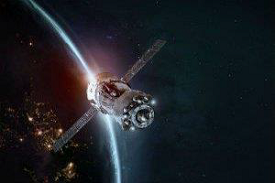
ISRO unveiled plan to set up its own space station in seven years. ISRO is to set up a very small and a separate space station. It will not be a part of the International Space Station (ISS). The project will be an extension of the Gaganyaan mission, which aims to send an Indian crew to space in 2022.
The weight of the space station will be around 20 tonnes. ISRO's proposal will be sent to the government for approval by 2022 after the first Gaganyaan mission. the mission is looking at 5-7 years to execute the programme. The cost of the proposed space station was not disclosed.
The International Space Station (ISS) is a partnership between European Space Agency, the United States (NASA), Japan (JAXA), Canada (CSA) and Russia (Roscosmos). It is the world's largest international cooperative programme in science and technology.hina also plans to build a space station of its own.
10 - MoSPI has proposed to set up a National Data Warehouse to leverage big data analytical tools

Ministry of Statistics and Programme Implementation (MoSPI) has proposed to set up a National Data Warehouse with an aim to leveraging big data analytical tools. This move is to further improve the quality of macro-economic aggregates. MoSPI also plans to introduce a legislative framework so that the National Statistical Commission (NSC) can function with independence and give holistic guidance for improving the national statistical system.
Significance
The move also lends its support to the system reforms that are currently ongoing. It will also ensure theresponsiveness to the changing needs of society that are necessary. This proposed set up is necessary as there are increasing demands on the statistical system for the production of relevant and quality statistics.
National Data Warehouse for macro-economic aggregate
The Ministry also proposed to establish a National Data Warehouse on Official Statistics. Here, the technology will be leveraged for using big data analytical tools for further improving the quality of macro-economic aggregates.
MoSPI has been criticized in some sections for the quality of macro-economic data.
Merger of merger of CSO and NSSO
Regarding this the government has recently merged the Central Statistical Organisation (CSO) and the National Sample Survey Office (NSSO) to streamline and strengthen the statistical system. The merger leveraged the strengths of the two organisations so that it can meet the increasing demands.
The government use the statistical data to revise the GDP estimate would require concomitant changes in the sectoral data flows and associated regulatory framework in the data source agencies to facilitate the use of more macro modelling techniques.
11 - Researchers found 2 childrens milk teeth in north eastern Siberia
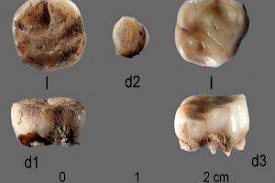
Researchers found two children's milk teeth buried deep in a remote archaeological site in northeastern Siberia. This discovery has revealed a previously unknown group of people who lived there during the last Ice Age.
The group of people have been named as the Ancient North Siberians and described their existence as a significant part of human history. Researchers said that this population does not appear to be the direct ancestor of Native Americans.
The DNA was recovered from the only human remains discovered from the era, two tiny milk teeth, that were found in a large archaeological site found in Russia near the Yana River.
12 - Google Maps launches features for real-time updates on public transports in India

Google tech Behemoth invented three new features- bus travel times from live traffic in 10 of the largest cities in India.
The live train status for Indian Railways trains, and mixed-mode commute suggestions that now combine auto-rickshaw and public transport.
The travel plan of Indian users are predicted by transit time while traveling on buses.
Google map enable users to know how long a bus trip will take when factoring in live traffic conditions
This feature launched in 10 cities namely Delhi, Bangalore, Mumbai, Hyderabad, Pune, Lucknow, Chennai, Mysore, Coimbatore, and Surat.
The partnership app is Where is My Train app acquired by Google in December 2018. It helped for Googles Next Billion Users initiative.
About Google Maps
The feature is live in two cities in Delhi and Bengaluru. India is the top three countries for Google Maps transit usage. The search engine over 300 million users in the country.
Google Map has more than 10,000 routes it can predict the transit time accurately. It will be available on Android and iPhones. Apple hiring spree to expand its products in India.
13 - India Test Fires Brahmos Supersonic Cruise Missile From Chandipur in Odisha'
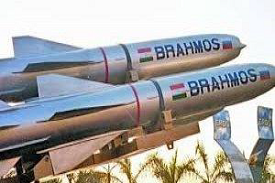
Supersonic cruise missileBrahMos was test fired from the Integrated Test Range (ITR) at Chandipur in Odisha.
Anti-ship version of the missile launched by complex-3 of the ITR, Defence Research and Development (DRDO) sources.
Worlds fastest supersonic cruise missile with high rate of accuracy
Missile is fired from land, sea and air.
The missile with a strike range of around 290 km is a strategic asset for India which act as a deterrence against any possible threats from China and Pakistan.
BrahMos is a joint venture between the DRDO and the NPOM(a Russian military technology firm) of Russia.
BrahMos operationalized in the Indian Army, Indian Navy, and Indian Air Force.
Senior defence officials and scientists from DRDO and BrahMos witnessed the trial
Origin and history of Brahmos
It brings a supersonic speed when it is separated. At the second stage then takes the missile closer to 3 Mach speed in cruise phase. Stealth technology and guidance system with advanced embedded software provides the missile an extraordinary performance
Type: Cruise missile; Air-launched cruise missile.
Variants: Ship-launched; Surface-launched.
Manufacturer: BrahMos Aerospace Limited
Place of origin: India / Russia
About Brahmos
Speed: Mach 2.8Mach 3
Unit cost: US$2.73 million
Place of origin: India / Russia
Manufacturer: BrahMos Aerospace Limited
14 - James Webb Space Telescope successfully passed final thermal vacuum test
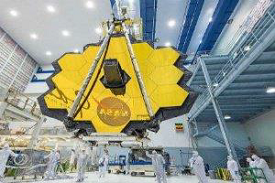
NASA's $8.8-billion James Webb Space Telescope, the world's largest and most expensive one, has successfully passed final thermal vacuum test, making its parts cleared for use in space.
The 6.5-meter diameter telescope has 18 gold-coated mirrors and a tennis court-sized sun-shield to gather light and protect its instruments. The telescope set to launch in 2021. It took 20 years to build.
James Webb Space Telescope (JWST)
Operators: NASA / ESA / CSA / STScI
Mission duration: 5 years (design), 10 years (goal)
Launch date: March 30, 2021 (planned)
Launch mass: 6,500 kg
It is planned to be the successor to the Hubble Space Telescope.
It will provide greatly improved resolution and sensitivity over the Hubble and will enable a broad range of investigations across the fields of astronomy and cosmology.
15 - Astronomers discovered the Forbidden Planet, NGTS- 4b in the Neptunian Desert
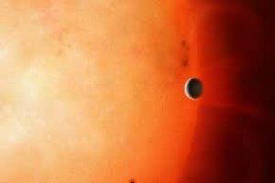
An international collaboration of astronomers with the University of Warwick, I-JK, have discovered an exoplanet, Next-Generation Transit Survey(NGTS)- 4b, the Forbidden Planet, in the Neptunian Desert.
It is smaller than Neptune but 3 times the size of the Earth.
The Research was led by Dr. Richard West including Professor Peter Wheatley, Dr. Daniel Bayliss and Dr. James McCormac from the Astronomy and Astrophysics Group at the University of Warwick.
This information was published in the Journal Monthly Notices of the Royal Astronomical Society(MNRAS).
The Forbidden Planet with a mass of 20 Earth masses, radius 20% smaller than Neptune and temperature of 1000 degree Celsius, orbits around the star in only 1.3 days and its atmosphere as gases.
NGTS, situated at the European Southern Observatory Paranal Observatory in the Atacama Desert, Chile.
16 - ISRO partnered with IAF for Gaganyaan astronaut selection, training
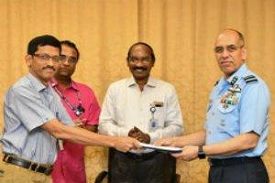
The Indian Air Force (IAF)has signed an agreement with the Indian Space Research Organisation (ISRO) for crew selection and training for the prestigious Gaganyaan, the country's maiden manned mission.
AVM RGK Kapoor, ACAS Ops (Space), IAF handed over the MoU to Shri R Hutton, Project Director of Gaganyaan Programme.
Agreement
Under the programme, a three-member crew will spend a minimum of seven days in space.
A human-rated GSLV Mk-lll will be used to carry the orbital module, which will have necessary provisions for sustaining a three-member crew for the duration of the mission.
The Institute of Aerospace Medicine (IAM) will lead the selection and training of astronauts on behalf of IAF.
The necessary infrastructure for crew training, a realization of flight systems and ground infrastructure will be established to support the program.
The ISRO will collaborate extensively with national agencies, laboratories, academia, and industry to accomplish the objectives of the prestigious mission.
Gaganyaan Mission
Gaganyaan ("Sky Craft") is an Indian crewed orbital spacecraft intended to be the basis of theIndian Human Spaceflight Programme.
Gaganyaan was announced by Prime Minister Narendra Modi in 2018.
The mission worth Rs. 10,000 crore.
The Programme is aimed to be launched by December 2021.
It was approved by the Union Cabinet in 2018.
In its maiden crewed mission, ISRO's largely autonomous 3.7-tonne capsule will orbit the Earth at 400 km (250 mi) altitude for up to seven days with a three-person crew on board.
17 - Facebook plans to launch its cryptocurrency, GlobalCoin, by the first quarter of 2020

Facebook plans to launch its cryptocurrency by the first quarter of 2020. The company is expected to reveal more details about the currency before testing begins later in 2019. The currency, which is being referred to internally as GlobalCoin, will reportedly be available in around a dozen countries at launch, where its expected to offer people affordable and secure payments without the need for a bank account.
The currency will need to overcome numerous technical and regulatory hurdles before it can be launched. Facebook CEO Mark Zuckerberg met with the Bank of Englands governor Mark Carney to discuss the opportunities and risks of the planned digital currency.
India-Key focus
However, Facebook might have a harder job on its hands in India, which has taken a hostile attitude towards virtual currencies. India is reported to be a key focus for the new currency, where Facebook hopes it will allow Indian workers abroad to send money back home to their families using WhatsApp.
What is a Cryptocurrency?
A cryptocurrency is a digital or virtual currency that uses cryptography for security. A cryptocurrency is difficult to counterfeit because of this security feature. It is not issued by any central authority, rendering it theoretically immune to government interference or manipulation.
The first blockchain-based cryptocurrency was Bitcoin, which still remains the most popular and most valuable. Today, there are thousands of alternate cryptocurrencies with various functions or specifications.